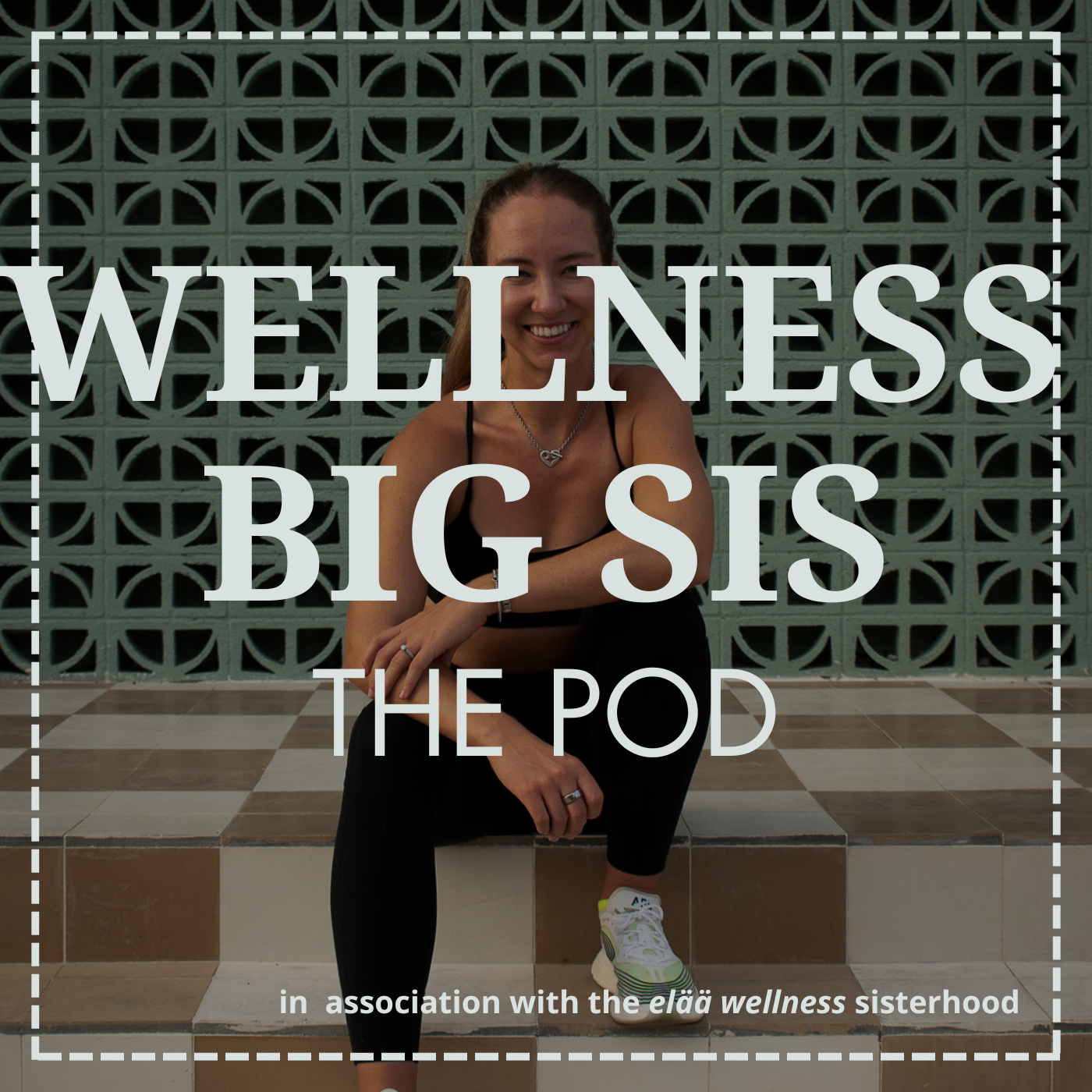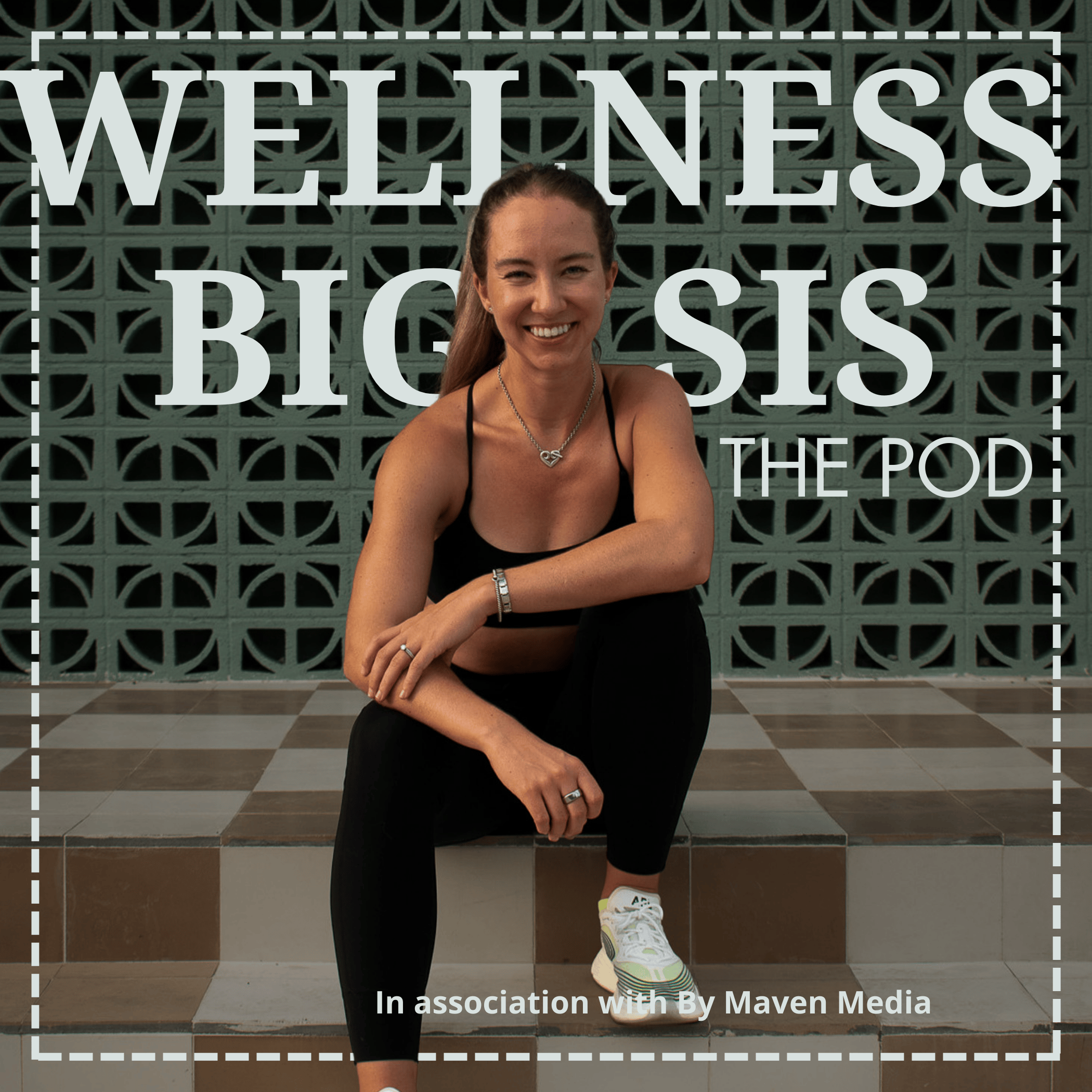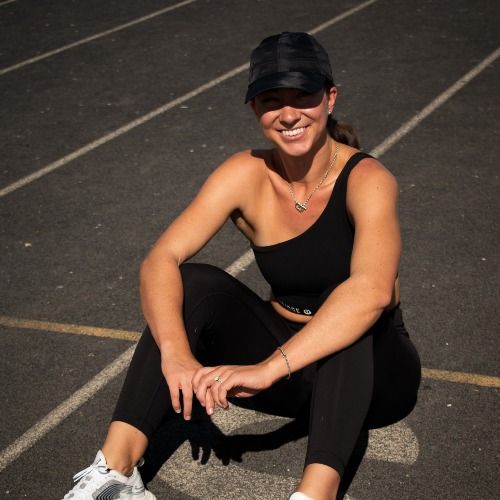81:: 10 health & wellness jump scares (Halloween special!)
This week, we’re diving into some science that might just blow your mind — starting with the fact that sperm aren’t just built for fertilization. In reality, only a small fraction of sperm are meant to fertilize an egg. The rest? They work together to create the perfect environment for fertilization to even happen. From neutralizing vaginal acidity to distracting the immune system’s “guards,” sperm are strategic little players.
We’ll also break down:
- Male fertility & pregnancy outcomes: How paternal health can impact preeclampsia risk and why sperm function is more complex than you think.
- Female physiology & training: Why your early strength gains have nothing to do with bigger muscles, and how your cycle affects motivation, energy, and endurance.
- Creatine & the luteal phase: Why creatine loading can help with energy, mood, and bloating during the second half of your menstrual cycle.
- Pain science myths: Pain isn’t just a signal from injured tissue—it’s your brain’s interpretation of threat.
- Body fat and menstrual cycles: The minimum body fat needed to start and maintain your period, and why this matters for athletes.
- Breastfeeding 101: Why milk production is hormonally driven at first, and why regulating it early on isn’t always in your control.
- Fat loss facts: Why you can’t spot-treat fat loss and what actually works for body composition changes.
- Muscle fibers in women: Why women’s muscles resist fatigue longer and why HIIT and SIT might give us more bang for our buck than endless Zone 2.
Whether you’re here for the science, the menstrual cycle tips, or just a better understanding of your body (and his), this episode is packed with evidence-based gems.
Dr. Katie Hirsch episode:
Board-Certified Lactation Consultant Episode:
https://wellness-big-sis-the-pod.captivate.fm/episode/copy-of-img-0565/
Male Fertility Episode:
Female muscle physiology episodes:
https://wellness-big-sis-the-pod.captivate.fm/episode/75-/
loving the pod? click the follow button, & we'd love if you could leave a review! thank you x 1000 :)
sign up for the free Wellness Girl Chats newsletter!
Want a peak into what it is like building this business, the podcast interviews, and all things female founder BTS? sign up for the free Firstborn Daughter Diary
insta:: @dr.kelsyvickdpt & @wellnessbigsispod
youtube:: @dr.kelsyvickdpt
tiktok:: @dr.kelsyvickdpt & @wellnessbigsispod
sign up for our patreon for exclusive content & workouts!
NEAP Protein: www.neapfoods.com
Safely Sidekick: http://livesafely.co/shop/drkelsy (or use code DRKELSY for 10% off)
Grab your very own Stakt Mat & Accessories for 10% off your order while also supporting the pod! (Thank you so much!):: https://shopstakt.com/?rave=DAW65UTUF4VNG7OV
Thorne Website:: https://s.thorne.com/Zgk7Y
My Thorne Dispensary & Recs:: https://www.thorne.com/u/drkelsyvickdpt
Message me for 35% off your Thorne orders!
00:18- 01:03 Welcome to the Halloween Special
01:04- 02:14 Surprising Facts About Sperm
02:15- 04:07 Creatine Loading for Women
04:08- 05:24 Understanding Pain Perception
05:25- 06:15 Menstrual Cycle and Motivation
06:52- 07:30 Body Fat and Menstrual Health
07:31- 08:06 Breastfeeding Insights
08:07- 08:39 The Truth About Spot Fat Reduction
08:40- 09:33 Male Fertility and Preeclampsia
09:34- 10:04 Initial Strength Gains Explained
10:05- 11:03 Female Skeletal Muscle Facts
11:04- 11:30 Halloween Wrap-Up
Mentioned in this episode:
Transcript
It's spooky season, so welcome
to a little Halloween special
2
:health and wellness jump scares
things about your body that
3
:might actually surprise you.
4
:Welcome back to Wellness Fixes the Pod.
5
:I'm your host, Dr.
6
:Kelsey Vick, a board certified
orthopedic doctor, physical therapy,
7
:and a pelvic floor physical therapist.
8
:And I figured it's a little bit of a
themed episode today, but I thought
9
:it'd be fun to chat about, maybe not
jump scares, but just surprising.
10
:Things about our bodies as women
primarily, but there's actually a
11
:few male fertility facts in here too,
because they do affect us as women.
12
:So I thought it'd be fun to talk
about 10 of the most surprising facts
13
:about our bodies and how they work.
14
:So it'll be a fun casual,
little spooky, fun fact episode.
15
:Number one, sperm aren't
just built for fertilization.
16
:This one isn't about our bodies as women,
but it's more of a male fertility fact.
17
:The minority of sperm released
are actually for fertilization.
18
:The majority of sperm that are released
are for creating the right environment
19
:for sperm to thrive, helping attack
some of the female immune response
20
:so that sperm can actually thrive and
flourish and fertilization can happen.
21
:So most sperm are actually
not related to fertilization.
22
:The female reproductive system is
extremely acidic, so it's very poor
23
:for sperm life and sperm movement.
24
:So some sperm helped to
neutralize the acidity.
25
:The female reproductive system is very
viscous, so it's like thick mucusy and
26
:it's very poor for sperm traveling.
27
:Of course.
28
:Just logistically it's harder to move
through a more viscous substance,
29
:so some sperm helps to liquefy the
environment a little bit more to
30
:help with the general motion of sperm
31
:And the female reproductive system
has a very strong immune response,
32
:which is good to ward off invaders,
but some sperm are actually in charge
33
:of distracting the guards, basically
to allow for fertilization to occur.
34
:Number two, this one's one of my
favorites, but creatine loading has
35
:been shown to help decrease some of
the more negative symptoms we have
36
:during the luteal phases of our cycles.
37
:And honestly all phases, but a lot of the.
38
:Negative side effects of our cycles
and the negative things that we go
39
:through happen in our luteal phase, and
creatine can help offset some of that.
40
:So there's a few recommendations.
41
:The normal recommendations are five
grams of creatine per day, but in
42
:your luteal phase, there's a potential
switch, and it's called creatine loading.
43
:It's five grams for four times a
day, so 20 grams a day total, but
44
:split into increments for five days,
followed by five grams twice a day.
45
:So you're moving from 20 grams a
day for five days to 10 grams a day
46
:For five days, and then you
can slowly titrate back down
47
:to five grams one time a day.
48
:But you still one serving is
still that five grams a day.
49
:It's not like you can just load up
20 grams at once and call it good.
50
:You do have to time it,
which can get tricky.
51
:I've been doing that over
the last few months since Dr.
52
:Katie Hirsh talked about it on her
episode, so I'll link that episode below.
53
:But yes, it is a little bit hard to
time it right to get the five grams
54
:just throughout the day, but it
has significantly helped with some
55
:of my symptoms during my luteal.
56
:So in our luteal phases, our
basal metabolic rate increases,
57
:meaning we require more a TP, more
energy for cellular functions.
58
:Hormonal shifts can lead to water
retention, bloating, breast tenderness,
59
:and there's neurotransmitter shifts that
can lead to mood changes, irritability,
60
:anxiety, and sleep disturbances.
61
:So creatine benefits us by
helping to reduce fatigue and
62
:improving our energy levels.
63
:Enhancing our cognitive function,
mood stabilization, and overall
64
:less bloating because it transitions
water from extracellularly, like
65
:where we might feel a little bit
more puffy to intracellularly,
66
:like in the muscle tissues.
67
:So I'll link that episode
that we did with Dr.
68
:Katie where she mentions this
below, but it's been a nice little
69
:tool in my toolbox, let's say,
to help her in the luteal phase.
70
:Number three, pain is not
a signal sent to our brain.
71
:We have no pain messengers, but
it is the response our brain comes
72
:up with if it feels we need to
be protected, if there's danger,
73
:And it doesn't just rely on the tissues.
74
:Damaged pain can be amplified by
other things, external circumstances.
75
:Our mental state, different
hormonal fluctuations, different
76
:chemicals within the brain.
77
:It's not just the tissue
damage that causes pain.
78
:There's actually been a study done.
79
:That pain can be amplified based on the
color that we see at the time of paint.
80
:So if we're seeing red light
and our hand touches an
81
:extremely cold surface, we will.
82
:Register that as more painful
than touching the exact same cold
83
:plate with a blue visual light.
84
:So there's different factors that
help our bodies to register Pain.
85
:Pain can also be amplified
based on past experiences.
86
:For example, neck pain is worse in
the general population and last longer
87
:compared to demolition derby drivers
who go through high impact collisions
88
:for their job all the time, so neck
pain in the general population who
89
:might not undergo this sort of job
or career is usually more intense
90
:and lasts longer compared to the neck
pain of demolition derby drivers.
91
:Number four.
92
:We have differences in motivation and risk
tolerance throughout our menstrual cycles.
93
:In the late follicular phase,
just before ovulation, we
94
:approach opportunities quicker.
95
:So we approach rewarding stimuli
quicker, especially as it relates
96
:to money or social rewards.
97
:And we overall have a
focus on opportunity.
98
:In this phase, in the mid
luteal phase, we have a quicker
99
:avoidance of negative stimuli.
100
:A lot of it has to do with.
101
:Evolution or there's a theory that
the reason we avoid these negative
102
:stimuli quicker in the luteal phase
is because should fertilization
103
:have occurred, our body wants
to protect that developing baby.
104
:So that's one of those evolutionary
theories for why this happens throughout
105
:our cycle, but we have a quicker
avoidance of negative stimuli, and
106
:there's a focus on threat avoidance
versus approaching opportunity.
107
:I can't even remember
what number we're on.
108
:I think five.
109
:But you need a certain amount of
body fat to even have a period.
110
:We need about 17% body fat in order
to start getting our periods and about
111
:22 to 28% to maintain our periods.
112
:This is why gymnasts, youth
runners, ballerinas, Their sport
113
:either promotes or has a tendency
towards lower body fat percentages.
114
:A lot of those girls get their periods a
little bit later because they don't quite
115
:have the body fat percentage minimum to
even get their periods in the first place.
116
:Another fun fact, fat is actually a
molecule that helps with our hormonal
117
:regulation from estrogen to leptin.
118
:So fat is definitely necessary.
119
:Number six, breastfeeding is
endocrine or hormonally driven
120
:for the first four to six weeks.
121
:Then it becomes baby driven.
122
:So when we talk about regulating milk
supply and different things, that four
123
:to six week mark is where that regulation
can start to occur, where it becomes
124
:baby driven and more pump driven.
125
:But those first four to six weeks, it
is hormonally and endocrine driven,
126
:which I learned this past May, when we
interviewed Sina, who's an international
127
:board certified lactation consultant,
and she actually told me that, and I
128
:thought that was so cool that our bodies
just know how to do that hormonally
129
:immediately after we have a baby.
130
:And then it becomes baby driven.
131
:Number seven, we cannot
spot treat fat loss.
132
:Fat loss is a systemic process.
133
:I feel like a lot of people are
starting to understand this,
134
:especially if you are listening
to a health and wellness podcast.
135
:You probably already realize this,
but when people say, lose your fat
136
:in your lower belly by doing more ab
workouts, lose that inner thigh fat
137
:by doing more inner thigh workouts
138
:It's not actually true.
139
:fat loss is systemic.
140
:We can't choose where we lose fat
from within our body or where we
141
:utilize fat for fuel within our bodies
through the exercises that we do.
142
:It just doesn't work like that.
143
:Number eight.
144
:Another male fertility fact that
actually affects us as women
145
:revolves around preeclampsia or high
blood pressure during pregnancy.
146
:the chance of preeclampsia in the female
was significantly higher with paternal.
147
:So father obesity compared
to the normal BMI group.
148
:As paternal BMI increases, the
rate of preeclampsia rises.
149
:13 to 19% of the development
of preeclampsia can be
150
:attributed to the male.
151
:We've done an entire male fertility
episode, so I'll link that below.
152
:That was during our Mama Palooza
Women's Health Podcast Festival event.
153
:Back in May, but I thought it was
interesting to start to look at
154
:the other side of the equation.
155
:Since oftentimes we focus on
156
:The female side of fertility, but
there's an entire male side of it too,
157
:obviously, that I feel like needs to
be talked about a little bit more.
158
:And what better way than to introduce
it to a bunch of girls and women who
159
:might be able to introduce it to their
significant others or partners, especially
160
:if they wanna get pregnant one day.
161
:Number nine, the initial
increase in strength.
162
:The first four-ish weeks of a new
strength training program actually
163
:has nothing to do with actually
increasing the size of your muscle.
164
:It has more to do with the
connectivity between your brain
165
:and your motor units, so it's more.
166
:About neuromuscular connections
versus actually just skeletal muscle.
167
:If you have better communication
from your brain to your muscles,
168
:you have better recruitment and
therefore increased strength.
169
:So that's in the first four-ish weeks.
170
:After that, then a lot of the strength
improvements start to come from actually
171
:increased muscle size or hypertrophy.
172
:And then lastly, female
specific skeletal muscle fact.
173
:So this is jump scare number 10.
174
:Women have more slow twitch fibers
than men, so we have better endurance
175
:overall, but slightly less power.
176
:Women's skeletal muscles, because we
have more type one fibers are also more
177
:fatigue resistant, Women's skeletal
muscle resists fatigue for longer than
178
:men during sub maximal tasks, even though
our overall strength is lower than men's.
179
:So just different sort of fun facts.
180
:We all have skeletal muscle tissue,
but the distribution between type one,
181
:which are those like slow twitch, more
endurance based muscle fibers, and
182
:type two, which are more of the fast
twitch speed, power-based fibers, the
183
:ratios differ between men and women.
184
:I'll link that episode where we chat
more in depth on that below if you're
185
:curious and wanna get a little bit
deeper into the science behind it and
186
:why women might need to prioritize
certain sprinting power-based activities
187
:more so than men, because we don't
necessarily have as many of those fibers.
188
:So we have to train it to improve it,
but then train it to also maintain.
189
:So happy Halloween to all
of those who celebrate.
190
:It's not my favorite holiday necessarily.
191
:, I'm a scaredy cat, honestly, but
I feel like it's a fun little
192
:Halloween special episode.
193
:My look is a little Halloween togo's
joining me right here for He, he
194
:wanted to make a little appearance
on this Halloween episode too.
195
:So I hope you guys enjoyed these 10 health
and wellness jump scares in honor ofs.
196
:Spooky season and I'll see you
guys again on the next episode
197
:of Wellness Exists, the pod.


